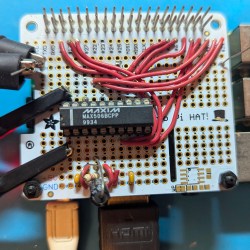[Aaron Lager]’s Pi-O-Scope-Pong project takes a minimal approach to Pong by drawing on an oscilloscope to generate crisp paddles and ball. A Raspberry Pi takes care of the grunt work of signal generation, and even uses the two joysticks of an Xbox controller (connected to the Pi over Bluetooth) for inputs.
 Originally, [Aaron] attempted to generate the necessary signals directly from the Pi’s PWM outputs by doing a little bit of RC filtering on the outputs, but was repulsed by the smeary results. The solution? An old but perfectly serviceable 8-bit MAX506 DAC now handles crisping up the visuals with high-quality analog outputs. Code is available on the project’s GitHub repository.
Originally, [Aaron] attempted to generate the necessary signals directly from the Pi’s PWM outputs by doing a little bit of RC filtering on the outputs, but was repulsed by the smeary results. The solution? An old but perfectly serviceable 8-bit MAX506 DAC now handles crisping up the visuals with high-quality analog outputs. Code is available on the project’s GitHub repository.
There isn’t any score-keeping or sound, but one thing that it has over the original Pong is a round ball. The ball in the original Pong game was square, but mainly because cost was a concern during design and generating a round ball would have ballooned the part count.
In many ways, Pong itself is a great inspiration for the Tiny Games Challenge, because the simplicity of its gameplay was likely a big part of its success.


















